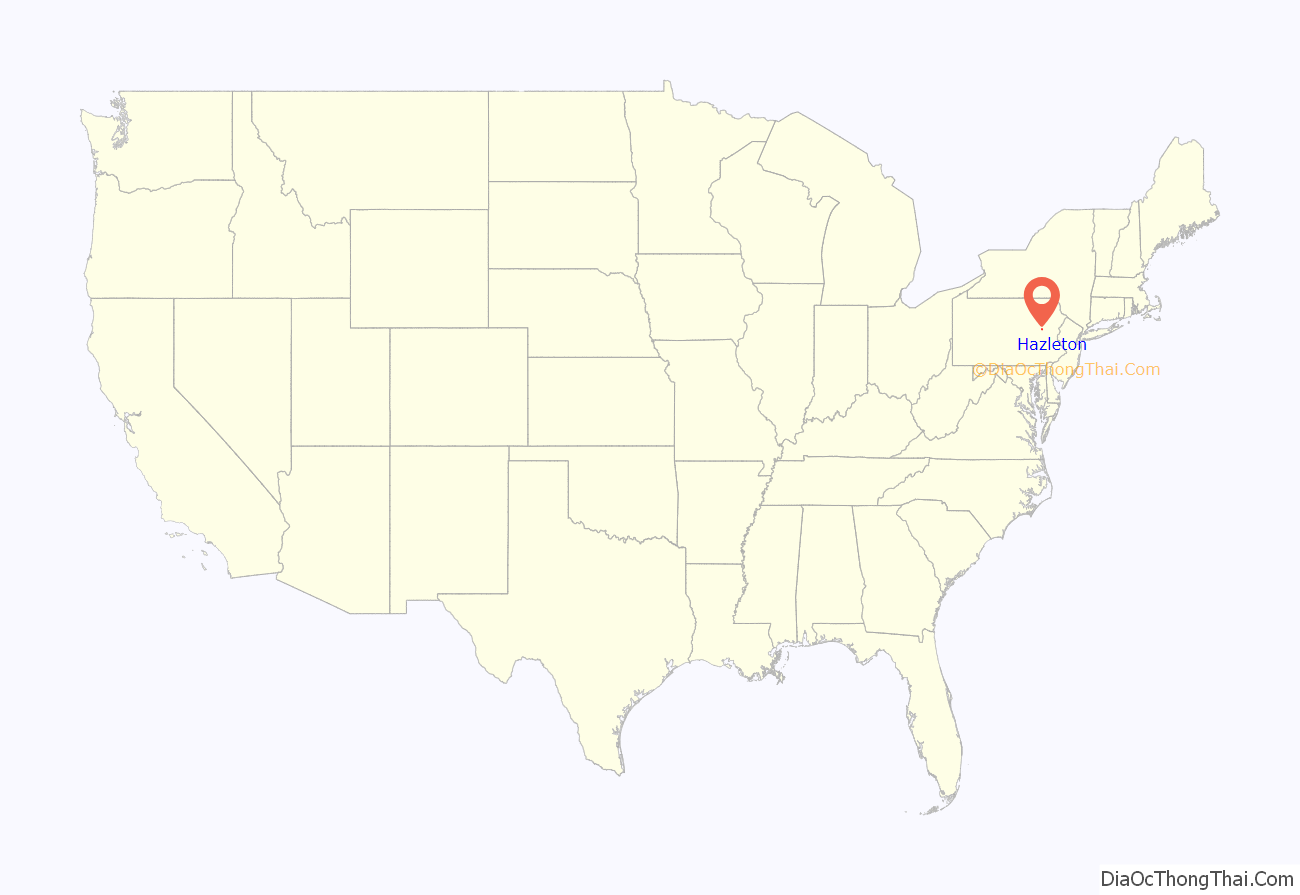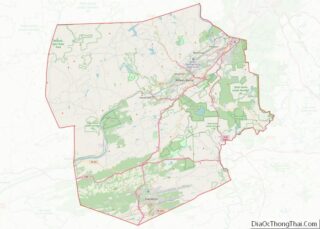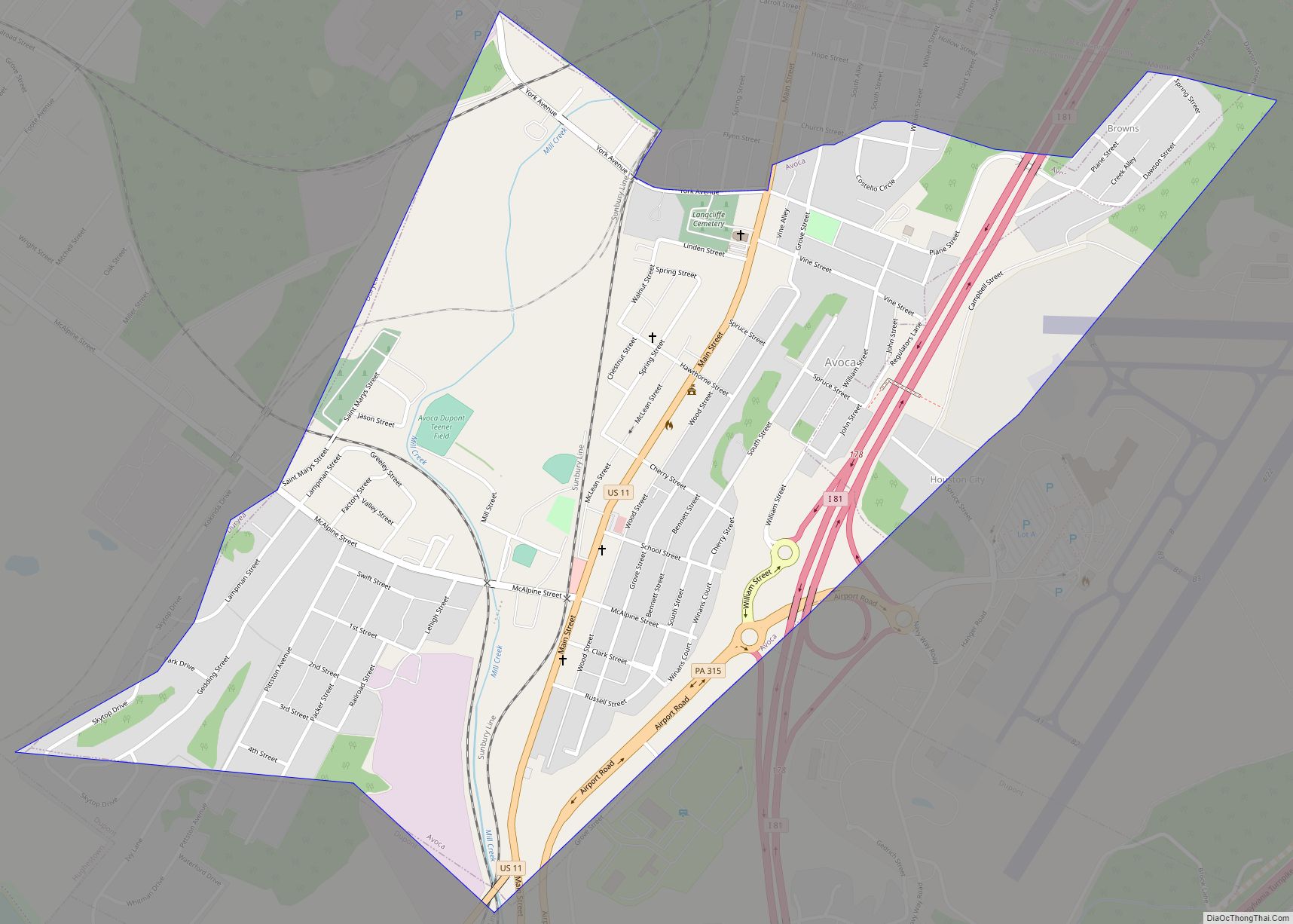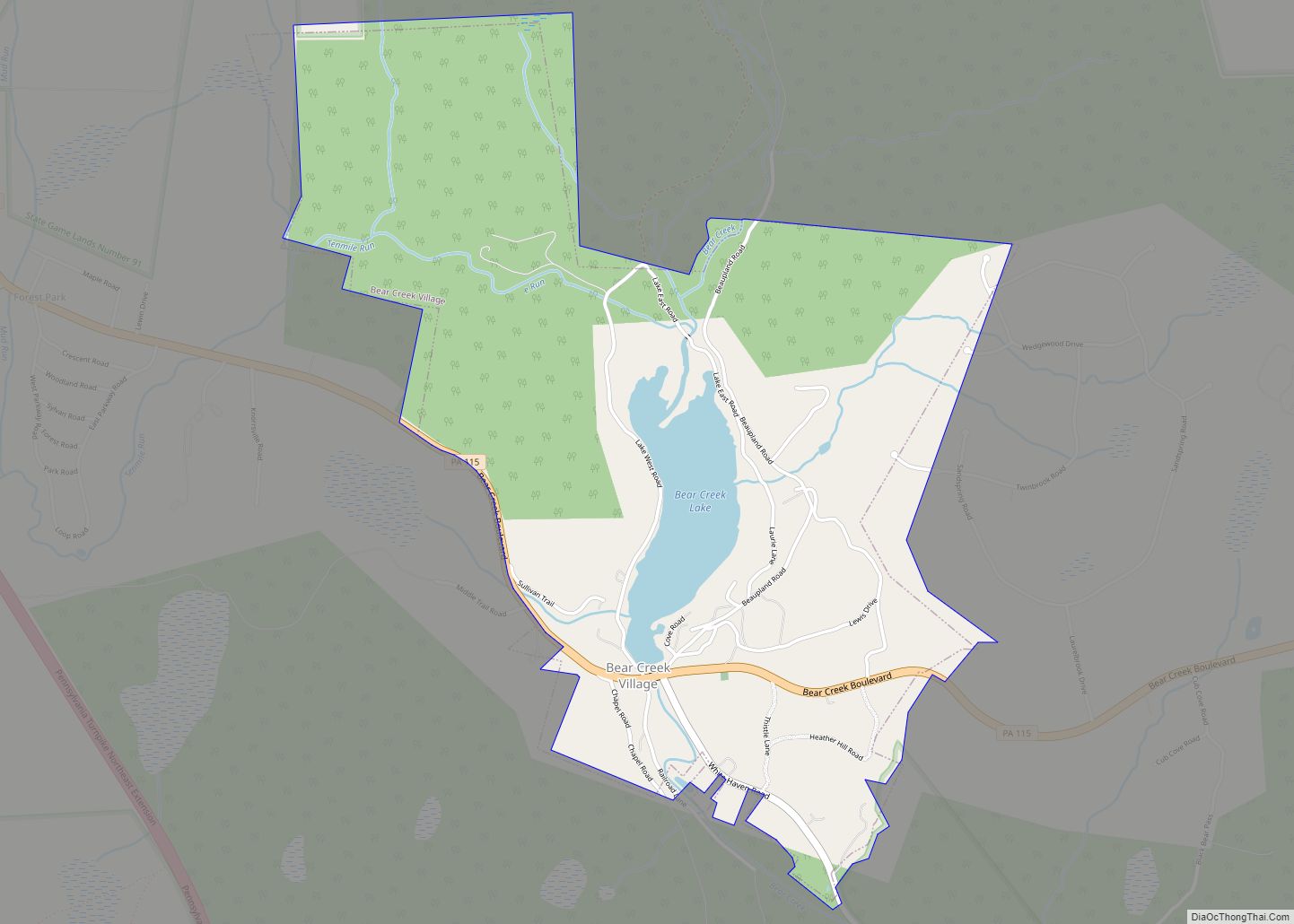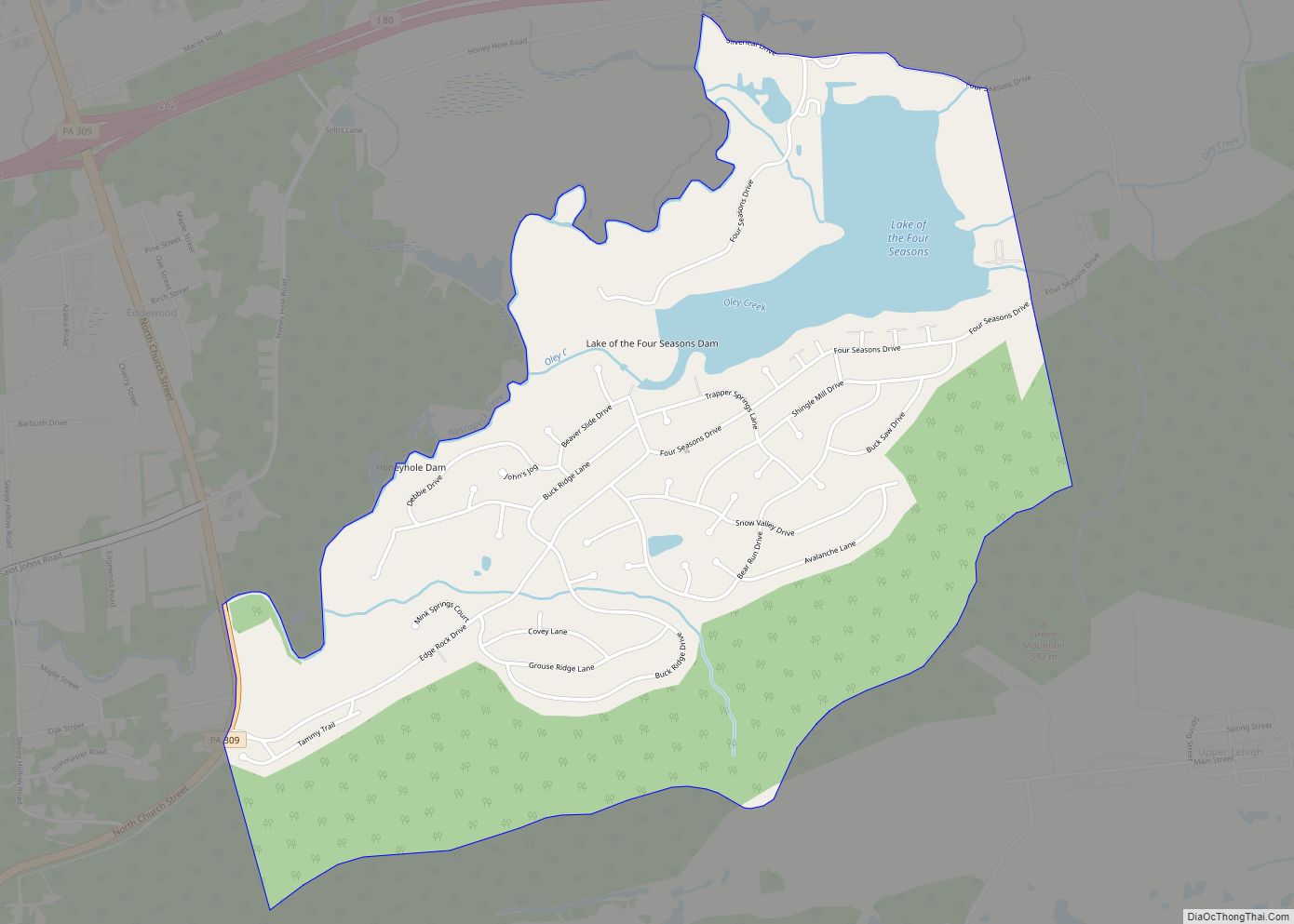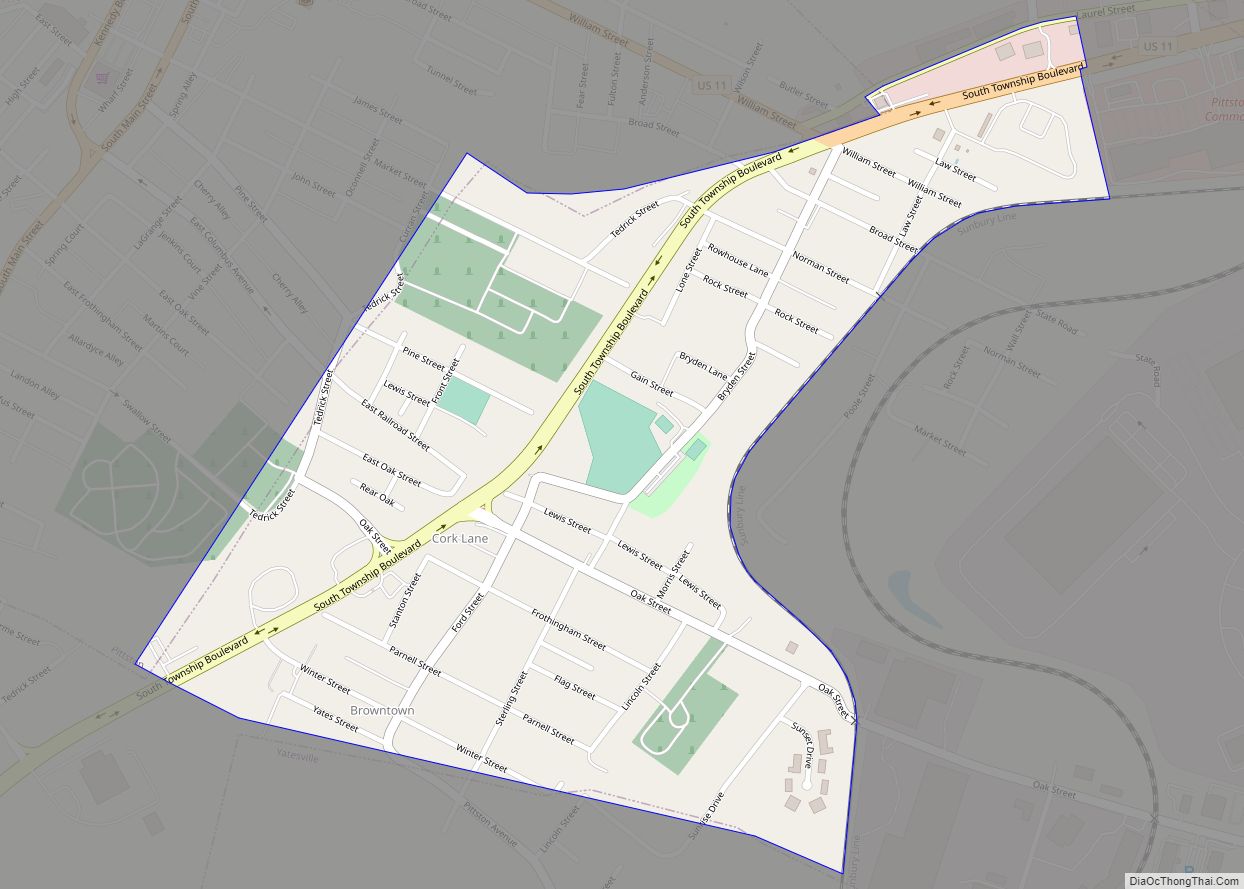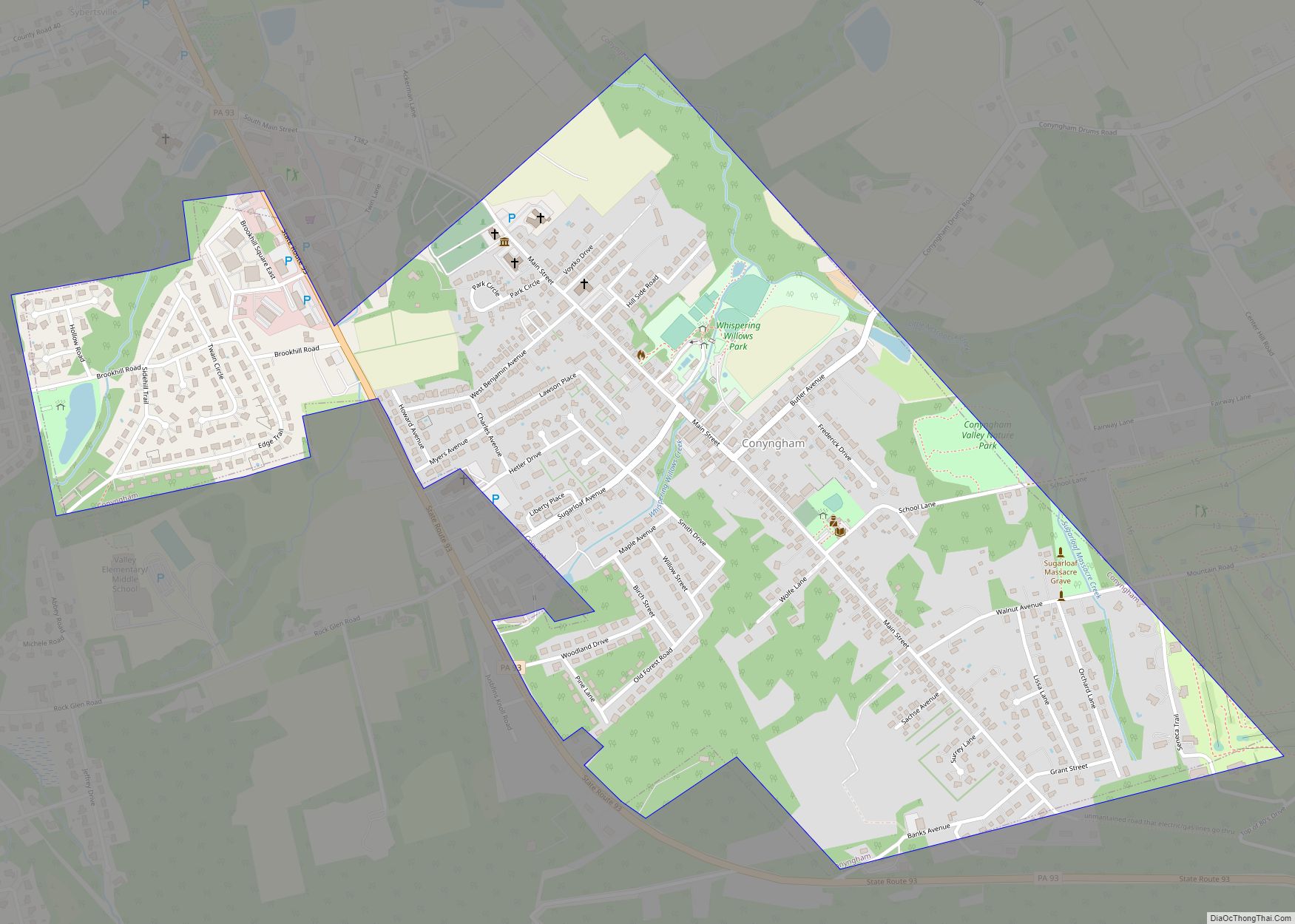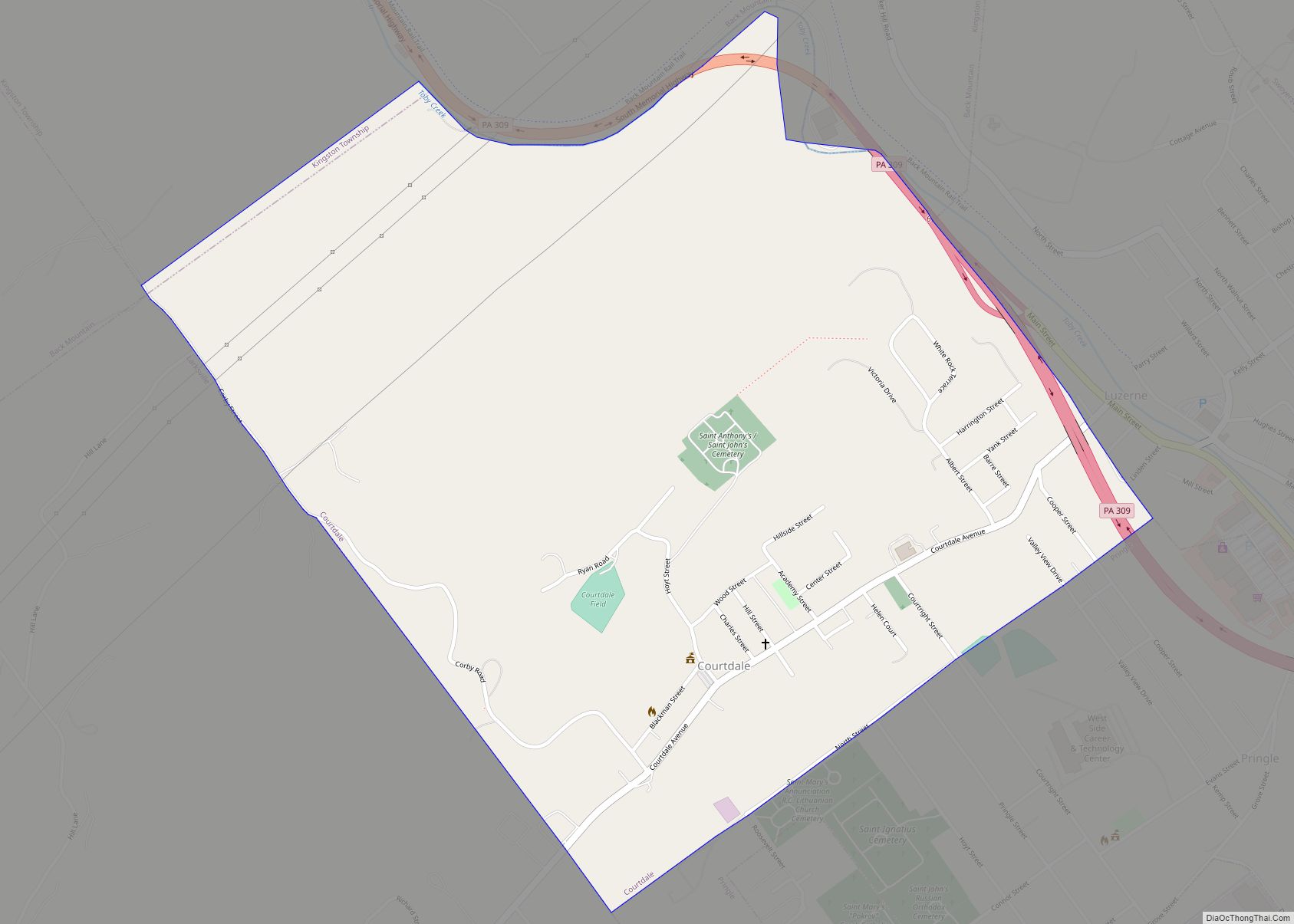Hazleton is a city in Luzerne County, Pennsylvania, United States. The population was 29,963 at the 2020 census. Hazleton is the second largest city in Luzerne County. It was incorporated as a borough on January 5, 1857, and as a city on December 4, 1891.
Hazleton is located in Northeastern Pennsylvania, 48.4 miles (77.9 km) north of Allentown and 126.7 miles (203.9 km) west of New York City.
| Name: | Hazleton city |
|---|---|
| LSAD Code: | 25 |
| LSAD Description: | city (suffix) |
| State: | Pennsylvania |
| County: | Luzerne County |
| Elevation: | 1,689 ft (515 m) |
| Total Area: | 5.97 sq mi (15.47 km²) |
| Land Area: | 5.97 sq mi (15.47 km²) |
| Water Area: | 0.00 sq mi (0.00 km²) |
| Total Population: | 29,963 |
| Population Density: | 5,017.25/sq mi (1,937.17/km²) |
| Area code: | 570 and 272 |
| FIPS code: | 4233408 |
| Website: | www.hazletoncity.org |
Online Interactive Map
Click on ![]() to view map in "full screen" mode.
to view map in "full screen" mode.
Hazleton location map. Where is Hazleton city?
History
Sugarloaf massacre
During the height of the American Revolution, in the summer of 1780, British sympathizers (known as Tories) began attacking the outposts of American revolutionaries located along the Susquehanna River in the Wyoming Valley. Because of reports of Tory activity in the region, Captain Daniel Klader and a platoon of 41 men from Northampton County were sent to investigate. They traveled north from the Lehigh Valley along a path known as “Warrior’s Trail” (which is present-day Pennsylvania Route 93). This route connects the Lehigh River in Jim Thorpe (formerly known as Mauch Chunk) to the Susquehanna River in Berwick.
Captain Klader’s men made it as far north as present-day Conyngham, when they were ambushed by Tory militiamen and members of the Seneca tribe. In all, 15 men were killed on September 11, 1780, in what is now known as the Sugarloaf Massacre.
The Moravians, a Christian denomination, had been using “Warrior’s Trail” since the early 18th century after the Moravian missionary Nicolaus Ludwig Zinzendorf first used it to reach the Wyoming Valley. This particular stretch of “Warrior’s Trail” had an abundance of hazel trees. Though the Moravians called the region “St. Anthony’s Wilderness”, it eventually became known as “Hazel Swamp”, a name which had been used previously by the Native Americans. The Moravian missionaries were sent from their settlements in Bethlehem to the site of the Sugarloaf Massacre to bury the dead soldiers. Some Moravians decided to stay, and in 1782, they built a settlement (St. Johns) along the Nescopeck Creek, which is near the present-day intersection of Interstates 80 and 81.
Jacob Drumheller
In the late 18th and early 19th centuries, the Warrior’s Trail was revamped and widened. It was renamed the Berwick Turnpike. Later, a road was built to connect Wilkes-Barre to McKeansburg. This road intersected with the Berwick Turnpike. An entrepreneur named Jacob Drumheller decided that this intersection was the perfect location for a rest stop, so in 1809, he built the first building in what would later be known as Hazleton. Though a few buildings and houses were erected nearby, the area remained a dense wilderness for nearly 20 years. At the time, the area offered little more than small-scale logging. Jacob Drumheller is buried at Conyngham Union Cemetery.
Discovery of coal
In 1818, anthracite coal deposits were discovered in nearby Beaver Meadows by prospectors Nathaniel Beach and Tench Coxe. This caught the attention of railroad developers in Philadelphia. A young engineer from New York named Ariovistus “Ario” Pardee was hired to survey the topography of Beaver Meadows and report the practicality of extending a railroad from the Lehigh Canal in Jim Thorpe to Beaver Meadows. Knowing that the area of Beaver Meadows was already controlled by Coxe and Beach, Pardee bought many acres of the land in present-day Hazleton. The investment proved to be lucrative. The land contained part of a massive anthracite coal field. Pardee is known as the founding father of Hazleton because of these contributions and initially laying out the patch town that eventually became Hazleton.
Pardee incorporated the Hazleton Coal Company in 1836, the same year the rail link to the Lehigh Valley market was on the brink of being completed. Hazleton Coal Company built the first school on Church Street, where Hazleton City Hall is now located. Pardee also built the first church in Hazleton, located at the intersection of Church and Broad Streets, and the first private school in Hazleton, located on the south side of Broad Street between Wyoming and Laurel Streets. Pardee died in 1892. The following year, in 1893, his son, Israel Platt Pardee, built a three-story, 19-room mansion in Hazleton; it was added to the National Register of Historic Places in 1984.
The anthracite coal industry attracted many immigrants for labor. The first wave, in the 1840s and 1850s, consisted mostly of German and Irish immigrants. The second wave, from the 1860s to the 1920s, consisted mostly of Italian, Polish, Russian, Lithuanian, Slovak, and Montenegrin immigrants. The coal mined in Hazleton helped establish the United States as a world industrial power, including fueling the massive blast furnaces at Bethlehem Steel.
Patch towns
Many small company towns, often referred to by locals as “patch towns” or “patches”, surrounded Hazleton. They were built by coal companies to provide housing for the miners and their families. The following is a list of “patch towns” in and around Hazleton:
- Beaver Meadows, coal was discovered here
- Stockton, founded by John Stockton
- Jeansville, founded by James Milens
- Milnesville, founded by James Milens
- Tresckow, formerly known as Dutchtown
- Junedale, formerly known as Colraine
- Freeland, originally called Freehold (founded by Joseph Birkbeck in 1846)
- McAdoo, originally called Pleasant Hill, then Saylors Hill
- West Hazleton, founded by Conrad Horn
- Eckley, founded by Eckley B. Coxe
- Jeddo, named after a Japanese port to which coal was exported by the Hazleton Coal Company
- Hollywood, part of Hazleton, named before Hollywood, California
- Weatherly, a small borough outside of Hazleton
- Humboldt Village, a tiny village outside of Hazleton
Prosperity and tragedy
Hazleton was incorporated as a borough on January 5, 1857. “Hazelton” was intended to be the borough’s name, but a clerk misspelled it during its incorporation, and the name “Hazleton” has been used ever since. The borough’s first fire company, the Pioneer Fire Company, was organized in 1867 by soldiers returning home from the American Civil War. Hazleton was incorporated as a city on December 4, 1891. At the time, the population was estimated to be around 14,000 people. In 1891, Hazleton became the third city in the United States to establish a citywide electric grid.
On September 10, 1897, the Lattimer Massacre occurred near Hazleton. It resulted in the deaths of 19 unarmed striking miners of the Lattimer mine. The miners, mostly of Polish, Slovak, Lithuanian, and German ethnicity, were shot and killed by a Luzerne County sheriff’s posse. Scores more were wounded. The massacre was a turning point in the history of the United Mine Workers (UMW).
Hazleton was also struck by several mining disasters. Notable among these were the cave-ins at Sheppton, Jeanesville, and Stockton.
Mining disasters were not the only tragedies. In October 1888, a train crash killed 66 people near Mud Run when one passenger train crashed into the rear of another train on their way to White Haven. It was one of the worst train wrecks recorded in United States history.
20th and 21st centuries
Leading into the 20th century, Hazleton’s population drastically changed. The “boom period” in population was 1885 to 1920. In 1860, there were only about one thousand people in Hazleton, but by 1880, there were nearly seven thousand people, which quickly became thirty-two thousand by 1920. The population peaked in 1940 at thirty-eight thousand.
With increased population came increased business, from downtown storefronts to large campuses like Penn State Hazleton.
Before World War II, anthracite coal flourished as a major provider of fuel for the nation. After the war, the demand for coal began to decline as natural gas and electricity became preferred power sources; coal became a less needed commodity. Also devastating to Hazleton’s coal industry were two hurricanes (Diane and Hazel). They flooded the mines and brought an end to Hazleton’s deep mining. Unemployment soared, reaching 25-30%. With the demise of deep mining, strip mining would be utilized as long as it was economically advantageous. A new era was about to be born: the era of business and industry.
Some industry preceded the demise of coal. The Duplan Silk Corporation opened in Hazleton in 1899, and became the world’s largest silk mill. The garment industry thrived and was invested in by New York mobster Albert Anastasia.
In 1947, Autolite Corporation was looking to expand operations in the East and had been looking into Hazleton. Officials from Autolite came to the area and surveyed the land. In their report, they noted that Hazleton was a “mountain wilderness” with no major water route, rail route, trucking route, or airport. In response, several area leaders gathered to address these problems.
CAN-DO (Community Area New Development Organization) was formally organized in 1956 by founder Dr. Edgar L. Dessen. Their main goal was to raise money, through their “Dime A Week” campaign, in which area residents were encouraged to put a dime on their sidewalk each week to be collected by CAN-DO. The company raised over $250,000 and was able to purchase over 500 acres (2.0 km) of land, which was converted into an industrial park.
Because of CAN-DO’s efforts, Hazleton was given the All-America City Award in 1964. Hazleton’s economy is now based largely on manufacturing and shipping, facilitated by the relative closeness to Interstates 80 and 81. Five Pennsylvania highways also pass through the Hazleton area: Pennsylvania Route 309, Pennsylvania Route 93, Pennsylvania Route 924, Pennsylvania Route 424, and Pennsylvania Route 940.
An article published in December 2002 by U.S. News & World Report, “Letter from Pennsylvania: A town in need of a tomorrow”, reported on Hazleton’s shortcomings. It was criticized by local politicians and business leaders.
Immigration wave
The city experienced a demographic shift in the first years of the 21st century with the arrival of new immigrants: mostly from the Dominican Republic.
In 2006, Hazleton gained national attention as Republican Mayor Lou Barletta and council members passed the Illegal Immigration Relief Act. This ordinance was instituted to discourage hiring or renting to illegal immigrants. Initially, the ordinance levied an administrative fine of $100.00 per illegal immigrant rented to and a loss of permits for non-compliance. Another act passed concurrently made English the official language of Hazleton.
Mayor Barletta estimated that “as many as half” of the estimated 10,000 Hispanics who were living in Hazleton left the city when the ordinance was passed. The issue was covered by the television program 60 Minutes in 2006 and the Fox News show The O’Reilly Factor in March 2007.
The ordinance was criticized as illegal and unconstitutional. A number of residents (landlords, business owners, lawful aliens defined as illegal under the act, and unlawful aliens) filed suit to strike down the law, claiming it violates the Supremacy Clause of the U.S. Constitution as well as the First and Fourteenth Amendments to the Constitution. After a trial and several appeals (including a remand from the Supreme Court), the Third Circuit found the ordinance invalid due to federal preemption.
As of 2015, nearly 40 percent of Hazleton’s population was of Hispanic or Latino descent. In 2012, Amilcar Arroyo, a Hazleton Integration Project board member, estimated that 80% of Hazleton’s Hispanics and Latinos were of Dominican origin, and that many of them had ancestry from San José de Ocoa. Hazleton has the highest percentage of Dominicans in Pennsylvania and the fourth highest in the nation. Many Dominicans had moved to Hazleton from portions of New York City, including The Bronx and Brooklyn) and parts of North Jersey, such as Newark and Paterson. Many of these migrants had families that were relatively large.
Many Hispanic and Latino businesses are on Wyoming Street, the linguistic landscape of which Spier and Ruano (2021) investigated in light of Barletta’s aforementioned comments. In 2016, The Philadelphia Inquirer reported that the Wyoming Street corridor was revived from a moribund state. Also, in 2016, the Hispanic and Latino population became the majority, at 52%, with White residents, many descended from Irish, Italian, and German immigrants, comprising 44% of the population.
Hazleton Road Map
Hazleton city Satellite Map
Geography
Hazleton is located at 40°57′32″N 75°58′28″W / 40.95889°N 75.97444°W / 40.95889; -75.97444 (40.958834, −75.974546). According to the U.S. Census Bureau, the city has a total area of 6.0 square miles (16 km), all land. Hazleton is located 12 miles (19 km) north of Tamaqua and 30 miles (48 km) south of Scranton/Wilkes-Barre. The city is located in Pennsylvania’s ridge and valley section (on a plateau named Spring Mountain). Hazleton’s highest elevation is 1,886 feet above sea level, making it one of the highest incorporated cities east of the Mississippi River and the highest incorporated city in Pennsylvania. It straddles the divide between the Delaware and Susquehanna River watersheds.
Greater Hazleton
Hazleton and its surrounding communities are collectively known as Greater Hazleton. Greater Hazleton encompasses an area located within three counties: southern Luzerne County, northern Schuylkill County, and northern Carbon County. The population of Greater Hazleton was 77,187 at the 2010 census. Greater Hazleton includes the City of Hazleton; the boroughs of Beaver Meadows, Conyngham, Freeland, Jeddo, McAdoo, Weatherly, West Hazleton, White Haven; the townships of Black Creek, Butler, East Union, Kline, Foster, Hazle, Rush, Sugarloaf; and the towns, villages, or CDPs of Audenried, Coxes Villages, Drifton, Drums, Ebervale, Eckley, Fern Glen, Haddock, Harleigh, Harwood Mines, Hazle Brook, Highland, Hollywood, Hometown, Hudsondale, Humboldt Village, Humboldt Industrial Park, Japan, Jeansville, Junedale, Kelayres, Kis-Lyn, Lattimer, Milnesville, Nuremberg, Oneida, Pardeesville, Quakake, St. Johns, Sandy Run, Still Creek, Stockton, Sybertsville, Ringtown, Sheppton, Tomhicken, Tresckow, Upper Lehigh, Weston, and Zion Grove.
See also
Map of Pennsylvania State and its subdivision:- Adams
- Allegheny
- Armstrong
- Beaver
- Bedford
- Berks
- Blair
- Bradford
- Bucks
- Butler
- Cambria
- Cameron
- Carbon
- Centre
- Chester
- Clarion
- Clearfield
- Clinton
- Columbia
- Crawford
- Cumberland
- Dauphin
- Delaware
- Elk
- Erie
- Fayette
- Forest
- Franklin
- Fulton
- Greene
- Huntingdon
- Indiana
- Jefferson
- Juniata
- Lackawanna
- Lancaster
- Lawrence
- Lebanon
- Lehigh
- Luzerne
- Lycoming
- Mc Kean
- Mercer
- Mifflin
- Monroe
- Montgomery
- Montour
- Northampton
- Northumberland
- Perry
- Philadelphia
- Pike
- Potter
- Schuylkill
- Snyder
- Somerset
- Sullivan
- Susquehanna
- Tioga
- Union
- Venango
- Warren
- Washington
- Wayne
- Westmoreland
- Wyoming
- York
- Alabama
- Alaska
- Arizona
- Arkansas
- California
- Colorado
- Connecticut
- Delaware
- District of Columbia
- Florida
- Georgia
- Hawaii
- Idaho
- Illinois
- Indiana
- Iowa
- Kansas
- Kentucky
- Louisiana
- Maine
- Maryland
- Massachusetts
- Michigan
- Minnesota
- Mississippi
- Missouri
- Montana
- Nebraska
- Nevada
- New Hampshire
- New Jersey
- New Mexico
- New York
- North Carolina
- North Dakota
- Ohio
- Oklahoma
- Oregon
- Pennsylvania
- Rhode Island
- South Carolina
- South Dakota
- Tennessee
- Texas
- Utah
- Vermont
- Virginia
- Washington
- West Virginia
- Wisconsin
- Wyoming
